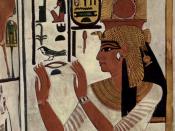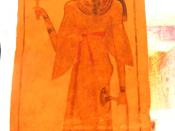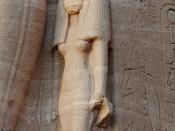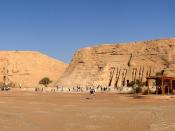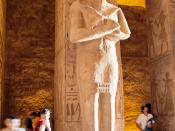Ancient Egypt - Ramesside Queens
Although not as influential as the queens of Dynasty XVIII, the Ramesside queens continued to play a prominent role. In the New Kingdom, the Queen became much more prominent and powerful. She acquired in her own right secular and religious titles that carried with them genuine jobs to do and estates with land, servants and administrators to provide an independent income. The title God's Wife of Amun provided the queen with her own source of money and gave her a considerable degree of independence. It is clear, that Queens such as Nefertari, Tiy, Tuya, Istnofret and Tauosret enjoyed this independence and played an important role in the running of Egypt and the Empire during its so-called, 'Glory days.'
It is very possible that Ramesses II's Chief Royal Wife (his favorite from many)- 'Nefertari', grew up as the daughter of a nobleman in Thebes. She most likely became Ramesses II's first wife when the prince was only 15.
It was Nefertari who bore Ramesses II his first male heir 'Amun-her-khepseshef' (Amun Is with His Strong Arm) as well as at least three more sons and two more daughters all after his ascension to the throne. It can be said that Nefertari certainly wielded a great deal of influence over Egypt during her time, she:
* Held titles 'King's Great Wife', 'Mistress of the South and the North' and 'Lady of the Two lands'
* Epithet 'Beloved of Mut'
* Was possibly the granddaughter, daughter or niece of Ay
* Accompanied Ramesses II on all ceremonial occasions e.g. investitures, religious festivals and processions.
* Is depicted in offering scenes with Ramesses II at Karnak, Luxor and Gebel el Silsila
* Has a temple dedicated to her at Abu Simbel
* Appeared in statuary on the faç;ade of temple of Ramesses II at Abu Simbel
* Was identified with the Godesses Hathor of Ishbek and Sothis
* Died between Years 24 and 30
* Was buried in a lavish tomb in the Valley of the Queens (QV66).
Ramesses II even went so far as to write this in relation to the weakness he felt for Nefertari's beauty:
"My love is unique - no one can rival her, for she is the most beautiful woman alive. Just by passing, she has stolen away my heart."
It is said that as Great Royal Wife, her high status and great authority within the royal court, along with her apparent beauty, charm, "sweetness", intelligence and guile, she may have been one of Egypt's greatest queens.
A description at Luxor Temple, says of her:
greatly favored, possessing charm, sweet of love.... Rich in love, wearing the circlet-diadem, singer fair of face, beautiful with the tall twin plumes, Chief of the Harim of Horus, Lord of the Palace; one is pleased with what(ever) comes forth concerning her; who has (only to) say anything, and it is done for her - every good thing, at her wish (?); her every word, how pleasing on the ear - one lives at just hearing her voice..."
Queen Tiy the Royal Wife of the Pharaoh Amenhotep III (1391-1353 B.C.) was (like Nefertari), also an intelligent and ambitious woman, involving herself in state affairs and official policies alongside that of her husband. Amenhotep married Tiy when she was 12 years old and showed a unwavering devotion to her through gratuitous gift-giving, and eventually by the construction of a temple for her in which she could be worshipped. Tiy was the mother of the Pharaoh Akhenaten and the grandmother of Tutankhamun.
It is interesting to note that the occurrence of her name with that of Amenhotep III throughout the written records, shows an official recognition of a queen which was very unusual throughout Egypt's glanderous history.
Queen Tuya comprises an important part of Egypt's history. Being the wife of Seti I and the mother of one of the greatest pharaohs of all time, (if not the greatest)- Ramesses II, she can be said to have started off this Egypt's greatest Dynasty. Queen Tuya (in her time), had been identified with the Goddess Hathor and also was part of a double shrine dedicated to her and Nefertari by Ramesses II himself at the Ramesseum. She was honored by Ramesses II in statuary at Abu Simbel, the Ramesseum and Pi-Ramesse and died in Year 22 being buried in the Valley of the Queens (QV80).
Though Nefertari is by far Ramesses II's most famous queen, Istnofret must have showed considerable importance within the King's court. She was, early on, Ramesses II's second principal wife, bearing his most important sons, including his successor, Merenptah, and the well known and loved Khaemwese, High Priest of the Temple of Ptah at Memphis. She is depicted with Ramesses II and children on rock stelae at Aswan and the Temple of Horemheb at Gebel el Silsila. It was she, after the death of Nefertari who became the Chief Royal Wife and consort of Ramesses II after Year 24, until her death 10 years later in Year 34.
Finally Queen Tauosret is one Queen who can be said to have exercised one of the most exultant influences over Egypt, more so, than Nefertari, Tuya, Tiy and Istnofret alike. She acted as the last Pharaoh of the Nineteenth Dynasty ruling over Egypt for 2 years, from about 1188-1186 BC, according to traditional Egyptian chronology. She took over from her step-son Siptah, who suffered from ill-health (probably polio) and her burial (is perhaps significant of her importance) as she was buried in the Valley of the Kings (KV14) and had a mortuary temple built for her near the Ramesseum.

